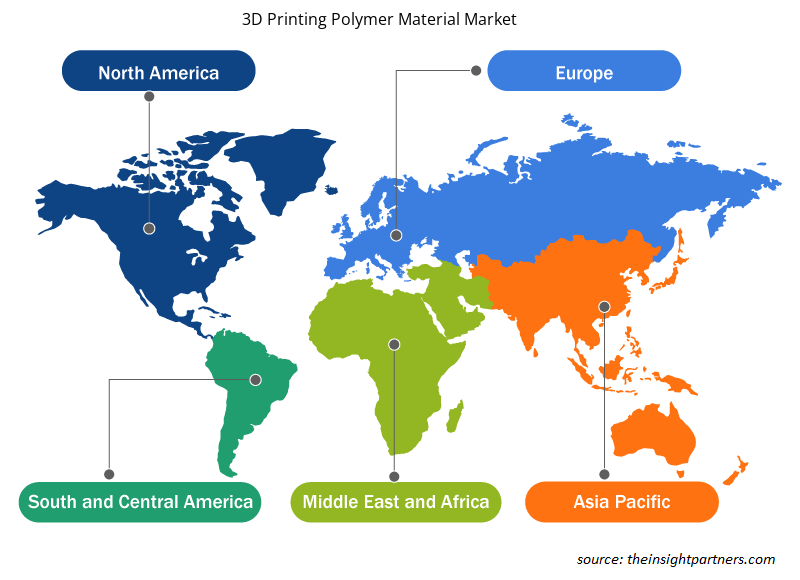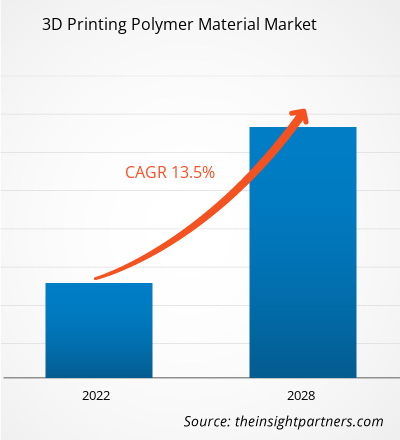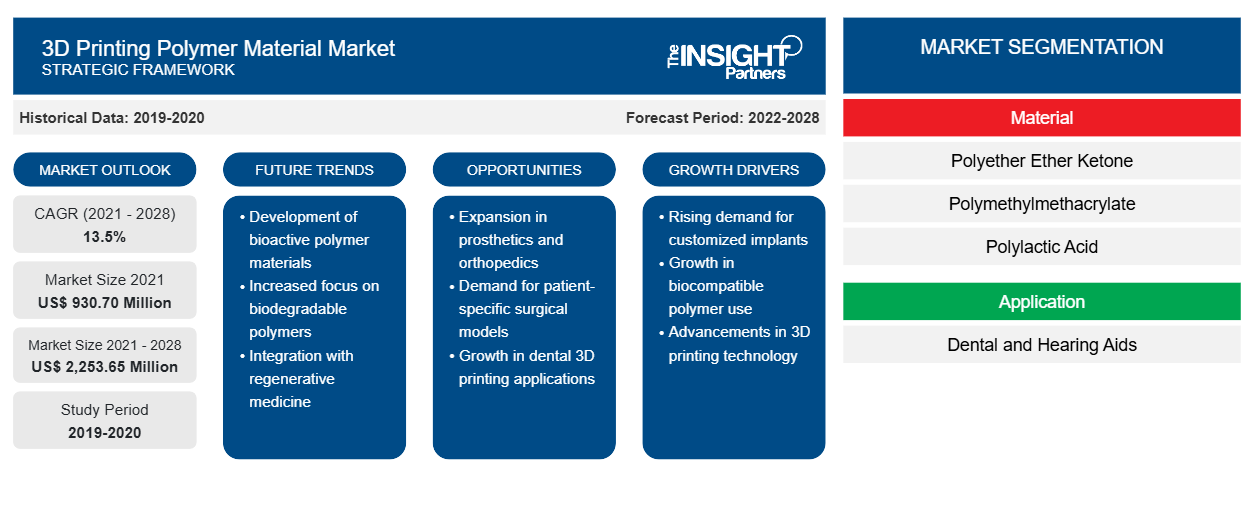Der Markt für 3D-Druck-Polymermaterialien für medizinische Anwendungen wurde im Jahr 2021 auf 930,70 Millionen US-Dollar geschätzt und soll bis 2028 2.253,65 Millionen US-Dollar erreichen; von 2021 bis 2028 wird ein durchschnittliches jährliches Wachstum von 13,5 % erwartet.
Polymere sind eines der wichtigsten 3D-Druckmaterialien. Der 3D-Druck von Polymeren ist eine aufstrebende Technologie, die in der Industrie, insbesondere im medizinischen Bereich, zunehmend Anwendung findet. 3D-Druckpolymermaterial besteht aus Polyetheretherketon, Polymethylmethacrylat und Polymilchsäure. Einer der Haupttreiber für das Wachstum des Marktes für 3D-Druckpolymermaterialien ist die zunehmende Verwendung des 3D-Drucks in der Zahnmedizin für verschiedene Anwendungen. In der Zahnmedizin hat die Verwendung des 3D-Drucks stark zugenommen. Die 3D-Drucktechnologie wird von Zahnärzten häufig verwendet, um beschädigte Zähne zu ersetzen oder zu reparieren, ein kieferorthopädisches Modell zu erstellen und Kronen, Kappen und Zahnersatz herzustellen.
Im Jahr 2020 hatte Nordamerika den größten Umsatzanteil am globalen Markt für 3D-Druckpolymermaterialien für medizinische Anwendungen . Die zunehmende Alterung der Bevölkerung und die zunehmende Belastung durch Lärm aufgrund der raschen Urbanisierung und Industrialisierung in Nordamerika führen zu einem Anstieg der gehörlosen Bevölkerung. Dies fördert die Nachfrage nach Hörgeräten und begünstigt in der Folge das Wachstum des nordamerikanischen Marktes für 3D-Druckpolymermaterialien für medizinische Anwendungen. Laut der Survey of Income and Program Participation (SIPP) sind in den USA über 600.000 Menschen gehörlos und etwa 28 Millionen der Bevölkerung des Landes leiden an partieller Schwerhörigkeit. Daher ist in der Region eine Nachfrage nach Hörhilfen zu verzeichnen, was den Herstellern von 3D-Polymermaterialien lukrative Möglichkeiten bietet, ihren Marktanteil in Nordamerika auszubauen.
Passen Sie diesen Bericht Ihren Anforderungen an
Sie erhalten kostenlos individuelle Anpassungen an jedem Bericht, einschließlich Teilen dieses Berichts oder einer Analyse auf Länderebene, eines Excel-Datenpakets sowie tolle Angebote und Rabatte für Start-ups und Universitäten.
- Holen Sie sich die wichtigsten Markttrends aus diesem Bericht.Dieses KOSTENLOSE Beispiel umfasst eine Datenanalyse von Markttrends bis hin zu Schätzungen und Prognosen.
Auswirkungen der COVID-19-Pandemie auf den Markt für 3D-Druck-Polymermaterialien für medizinische Anwendungen
Vor der COVID-19-Pandemie wuchs der Markt für 3D-Druckpolymermaterialien für medizinische Anwendungen aufgrund der hohen Nachfrage nach Polymeren im 3D-Druck zur Herstellung verschiedener medizinischer Geräte, Instrumente, kundenspezifischer Implantate und medizinischer Modelle. Im Jahr 2020 mussten jedoch verschiedene Branchen ihre Betriebsabläufe aufgrund von Störungen der Wertschöpfungsketten aufgrund der Schließung nationaler und internationaler Grenzen verlangsamen. Die COVID-19-Pandemie hat sich aufgrund von Lockdowns, Reiseverboten und Geschäftsschließungen negativ auf die Wirtschaft und Industrie in verschiedenen Ländern ausgewirkt. Die Nachfrage nach 3D-Druckpolymermaterialien für Anwendungen wie Zahnimplantate, Zahnprothesen, Implantatzubehör und Hörgeräte ist aufgrund der geringen Nachfrage nach diesen Produkten zurückgegangen. Während der COVID-19-Pandemie ist die Nachfrage nach 3D-Druckpolymeren für die Herstellung verschiedener persönlicher Schutzausrüstungen und medizinischer Geräte jedoch gestiegen. Der 3D-Druck von Polymeren hat sich während der Pandemie als praktikable Technologie zur Herstellung von Beatmungsventilen, Schutzbrillen, Gesichtsschutzschilden und Testtupfern etabliert.lockdowns, travel bans, and business shutdowns. The demand for 3D printing polymer materials in application such as dental implants, dental prosthetics, implant accessories, hearing aids has reduced due to low demand for these products. However, the demand for 3D printing polymers have increased during the COVID-19 pandemic for the production of different personal protective equipment and medical devices.
Markteinblicke
Zunehmender Einsatz von 3D-Druck in der Zahnmedizin
In der Zahnmedizin hat die Verwendung von 3D-Druck stark zugenommen. Der 3D-Druck bietet verschiedene Vorteile gegenüber den subtraktiven/Frästechniken. Er ermöglicht die einfache Herstellung komplexer Geometrien und reduziert den Materialabfall, der normalerweise beim Fräsen verloren geht. Mit dem 3D-Druck können mehrere Geräte gleichzeitig gedruckt werden. Auch die Genauigkeit wird durch den 3D-Druck verbessert. Die Anwendungsgebiete der 3D-Drucktechnologie in der Zahnmedizin sind vielfältig. Zahnerkrankungen sind in verschiedenen Ländern der Welt eine große Gesundheitsbelastung und beeinträchtigen die Menschen ein Leben lang. Laut Global Burden of Disease 2017 ist unbehandelte Karies in bleibenden Zähnen die häufigste Erkrankung. Die Prävalenz von Zahnerkrankungen nimmt mit zunehmender Urbanisierung und veränderten Lebensbedingungen weiter zu. Verschiedene Dentalprodukte, die mithilfe der 3D-Drucktechnologie hergestellt werden, finden umfassende Anwendung bei der Wiederherstellung der Zahnstruktur. Daher führt die hohe Inzidenz von Zahnkaries und anderen Zahnerkrankungen zu einer zunehmenden Verwendung von 3D-gedruckten Produkten in der Zahnmedizin.subtractive/milling techniques. It allows the production of complex geometries with ease and reduces wastage of material, which is generally lost to milling. 3D printing allows for multiple appliances to be printed at once. Accuracy is also improved with 3D printing. Applications of
Anwendungseinblicke
Basierend auf der Anwendung ist der globale Markt für 3D-Druckpolymermaterialien für medizinische Anwendungen in Zahnmedizin und Hörgeräte unterteilt. Das Dentalsegment hatte im Jahr 2020 einen größeren Anteil am Markt für 3D-Druckpolymermaterialien für medizinische Anwendungen. Das Wachstum des Marktes für 3D-Druckpolymermaterialien für medizinische Anwendungen für dieses Segment ist auf die hohe Akzeptanz von Polymermaterialien für die Gestaltung von Gerüststrukturen zurückzuführen, die auf ihre verbesserten biologischen und mechanischen Eigenschaften, ihre einfache Verarbeitung, ihre niedrigen Produktionskosten und ihre leichteren Eigenschaften als Metalle und Keramik zurückzuführen sind.
Evonik Industries AG; STRATASYS LTD; Formlabs; Henkel AG & COMPANY, KGAA; Arkema; BASF SE; Roboze; Bionic Production GmbH; Orion Additive Manufacturing GmbH; und Solvay SA gehören zu den Akteuren auf dem globalen Markt für 3D-Druck-Polymermaterialien für medizinische Anwendungen. Die Marktteilnehmer konzentrieren sich darauf, qualitativ hochwertige Produkte anzubieten, um die Kundennachfrage zu erfüllen.
Regionale Einblicke in den Markt für Polymermaterialien für den 3D-Druck
Die regionalen Trends und Faktoren, die den Markt für Polymermaterialien für den 3D-Druck im Prognosezeitraum beeinflussen, wurden von den Analysten von Insight Partners ausführlich erläutert. In diesem Abschnitt werden auch die Marktsegmente und die Geografie von Polymermaterialien für den 3D-Druck in Nordamerika, Europa, im asiatisch-pazifischen Raum, im Nahen Osten und Afrika sowie in Süd- und Mittelamerika erörtert.

- Erhalten Sie regionale Daten zum Markt für Polymermaterialien für den 3D-Druck
Umfang des Marktberichts zu Polymermaterialien für den 3D-Druck
| Berichtsattribut | Details |
|---|---|
| Marktgröße im Jahr 2021 | 930,70 Millionen US-Dollar |
| Marktgröße bis 2028 | 2.253,65 Millionen US-Dollar |
| Globale CAGR (2021 - 2028) | 13,5 % |
| Historische Daten | 2019-2020 |
| Prognosezeitraum | 2022–2028 |
| Abgedeckte Segmente | Nach Material
|
| Abgedeckte Regionen und Länder | Nordamerika
|
| Marktführer und wichtige Unternehmensprofile |
|
Dichte der Marktteilnehmer für Polymermaterialien im 3D-Druck: Auswirkungen auf die Geschäftsdynamik verstehen
Der Markt für Polymermaterialien für den 3D-Druck wächst rasant. Dies wird durch die steigende Nachfrage der Endnutzer aufgrund von Faktoren wie sich entwickelnden Verbraucherpräferenzen, technologischen Fortschritten und einem größeren Bewusstsein für die Vorteile des Produkts vorangetrieben. Mit der steigenden Nachfrage erweitern Unternehmen ihr Angebot, entwickeln Innovationen, um die Bedürfnisse der Verbraucher zu erfüllen, und nutzen neue Trends, was das Marktwachstum weiter ankurbelt.
Die Marktteilnehmerdichte bezieht sich auf die Verteilung der Firmen oder Unternehmen, die in einem bestimmten Markt oder einer bestimmten Branche tätig sind. Sie gibt an, wie viele Wettbewerber (Marktteilnehmer) in einem bestimmten Marktraum im Verhältnis zu seiner Größe oder seinem gesamten Marktwert präsent sind.
Die wichtigsten Unternehmen auf dem Markt für Polymermaterialien für den 3D-Druck sind:
- Evonik Industries AG
- STRATASYS LTD
- Formlabs
- Henkel AG & COMPANY, KGAA
- Arkema
Haftungsausschluss : Die oben aufgeführten Unternehmen sind nicht in einer bestimmten Reihenfolge aufgeführt.

- Überblick über die wichtigsten Akteure auf dem Markt für Polymermaterialien für den 3D-Druck
Bericht-Spotlights
- Fortschrittliche Branchentrends auf dem Markt für 3D-Druckpolymermaterialien für medizinische Anwendungen helfen den Akteuren bei der Entwicklung wirksamer langfristiger Strategien
- In Industrie- und Entwicklungsländern angewandte Strategien für Unternehmenswachstum
- Quantitative Analyse des Marktes für 3D-Druck-Polymermaterialien für medizinische Anwendungen von 2019 bis 2028
- Schätzung der weltweiten Nachfrage nach Polymermaterial für den 3D-Druck
- Porters Fünf-Kräfte-Analyse zur Veranschaulichung der Wirksamkeit der in der Branche tätigen Käufer und Lieferanten
- Aktuelle Entwicklungen zum Verständnis des wettbewerbsorientierten Marktszenarios
- Markttrends und -aussichten sowie Faktoren, die das Wachstum des Marktes für 3D-Druckpolymermaterialien für medizinische Anwendungen vorantreiben und bremsen
- Unterstützung im Entscheidungsprozess durch Aufzeigen von Marktstrategien, die das kommerzielle Interesse untermauern und zum Marktwachstum führen
- Die Größe des Marktes für 3D-Druck-Polymermaterialien für medizinische Anwendungen an verschiedenen Knotenpunkten
- Detaillierte Übersicht und Segmentierung des Marktes sowie der Dynamik der 3D-Druck-Polymermaterialindustrie
- Größe des Marktes für 3D-Druck-Polymermaterialien für medizinische Anwendungen in verschiedenen Regionen mit vielversprechenden Wachstumschancen
Markt für 3D-Druck-Polymermaterialien für medizinische Anwendungen
Material
- Polyetheretherketon
- Polymethylmethacrylat
- Polymilchsäure
- Sonstiges
Anwendung
- Zahnmedizin
- Zahnimplantate
- Zahnersatz
- Implantat-Zubehör
- Sonstiges
- Hörgeräte
Firmenprofile
- Evonik Industries AG
- STRATASYS LTD
- Formlabs
- Henkel AG & COMPANY, KGAA
- Arkema
- BASF SE
- Roboze
- Bionic Production GmbH
- Orion Additive Manufacturing GmbH
- Solvay SA
- Historische Analyse (2 Jahre), Basisjahr, Prognose (7 Jahre) mit CAGR
- PEST- und SWOT-Analyse
- Marktgröße Wert/Volumen – Global, Regional, Land
- Branchen- und Wettbewerbslandschaft
- Excel-Datensatz
Aktuelle Berichte
Verwandte Berichte
Erfahrungsberichte
Grund zum Kauf
- Fundierte Entscheidungsfindung
- Marktdynamik verstehen
- Wettbewerbsanalyse
- Kundeneinblicke
- Marktprognosen
- Risikominimierung
- Strategische Planung
- Investitionsbegründung
- Identifizierung neuer Märkte
- Verbesserung von Marketingstrategien
- Steigerung der Betriebseffizienz
- Anpassung an regulatorische Trends





















 Kostenlose Probe anfordern für - Markt für 3D-Druck-Polymermaterialien
Kostenlose Probe anfordern für - Markt für 3D-Druck-Polymermaterialien